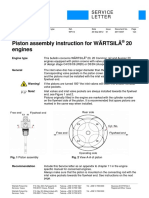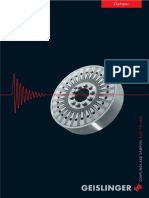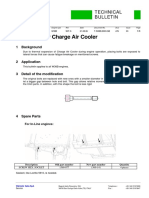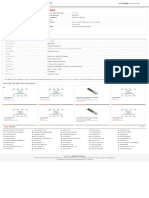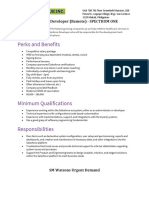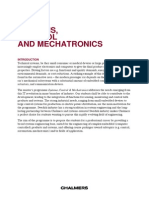Professional Documents
Culture Documents
ZXXC
ZXXC
Uploaded by
arness22Original Description:
Original Title
Copyright
Available Formats
Share this document
Did you find this document useful?
Is this content inappropriate?
Report this DocumentCopyright:
Available Formats
ZXXC
ZXXC
Uploaded by
arness22Copyright:
Available Formats
Service Bulletin
2
8
.
7
5
.
7
1
.
4
0
P
r
i
n
t
e
d
i
n
S
w
i
t
z
e
r
l
a
n
d
Wrtsil NSD Switzerland Ltd PO Box 414 Tel. +41 52 262 49 22
Wrtsil NSD Schweiz AG CH-8401 Winterthur Fax +41 52 212 49 17
Wrtsil NSD Suisse SA Switzerland Tlx 896 659 NSDL CH
1. Introduction 1
2. Pre-Adjusting of Fuel Pumps 1
3. Fuel Pump Adjustment 1
4. Deviations in Exhaust 2
Temperatures After Cylinder
5. Conclusion 3
6. Service Bulletins Published for 4
ZA 40S Engines
Contents: Page
ZAS37
25.02.2000
Technical Information to all Owners / Operators
of Sulzer ZA 40S Engines
Checking and Adjusting of
Fuel Injection Pumps
1 / 4 Service Bulletin ZAS-37
1. INTRODUCTION
With the different types of plungers also the adjustment values for the specific fuel pumps are
different. This Service Bulletin has been issued to support our clients in this matter and also to
give an overview of the different plunger types such as CIT (constant injection timing), VIT
(variable injection timing), Variable Damping Plungers and also how the adjustment must be
carried out.
This Service Bulletin should be kept in a separate file in the control room. The respective pages or
tables of the Service Bulletin with modifications to the Operating Manual, Maintenance Manual
or Code Book should be copied and filed in the respective Manual or Book.
2. PREADJUSTING OF FUEL PUMPS
Each time a fuel pump has been dismantled for overhaul and new parts have been fitted, the
pump must be preadjusted first. This can be done either outside of the engine, or with the pump
fitted on the engine. For easier handling we suggest to do the preadjustment of the fuel pump
outside the engine. For the adjustment outside of the engine a special tool (9444.01) which is
also used for dismantling the pump into its parts, as well as for the assembly has to be used. Very
important to get a correctly adjusted pump is also to have absolutely no air leakage between the
pump cover and the measuring device (945504).
3. FUEL PUMP ADJUSTMENT
All fuel pumps of an engine are adjusted such that the specified delivery stroke is achieved at a
load indicator position of 8.65 and at the same time the distance between the pump housing and
the clamping ring amounts to 10 0.03 mm. This fundamental adjustment with the specified
delivery stroke of the fuel pump must not under any circumstances be changed at a later date, as
it is a prerequisite for a balanced fuel delivery for all cylinders and, therefore, for a well
regulated engine.
All important values such as Load indicator position, Plunger identification No., Correction
value, Plunger diameter, and Specified delivery stroke for the different plunger and engine
types are listed in table 1 and 2. Actual detailed Adjusting Instructions are in possession of the
Service Personnel of our Network Companies and we recommend to call in one of our Service
Engineers for carrying out the fuel pump checking and adjusting.
LI Pos. Fuel Pump
Plunger
Engine Type Output
[kW/Cyl]
Speed
[rpm]
Plunger
diam.
[mm]
Specified delivery
stroke
[mm]
8.65 019
1)
ZA 40S
general
up to 750 500 / 510 / 514 35 15.88
8.65 617 ZA 40S
marine
up to 720 500 / 510 / 514 35 14.73
8.65 958 ZA 40S
general
up to 600 500 / 510 / 514 35 11.77
1)
Variable Damping plunger
Table 1: CIT plunger, including Variable Damping plunger
2 / 4 Service Bulletin ZAS-37
LI Pos. Fuel Pump
Plunger
Engine Type Output
[kW/Cyl]
Speed
[rpm]
Plunger
diam.
[mm]
Specified delivery
stroke
[mm]
Correction
value
8.65 542 ZA 40S
power plants
up to 720 500 / 510 / 514 35 14.73 2.07
8.65 466 ZA 40S
marine
up to 600 500 / 510 / 514 35 12.32 1.78
8.65 465 ZA 40S
power plants
up to 600 500 / 510 / 514 35 12.32 1.98
Table 2: VIT - plunger
4. DEVIATIONS IN EXHAUST TEMPERATURES AFTER CYLINDERS
Even a correctly adjusted engine with balanced fuel delivery and maximum cylinder pressures
within tolerances can, depending on the number of cylinders, exhibit individual temperatures
after cylinder which vary greatly from one another, as can be noted from the Acceptance Test
Results.
The reason for such deviations is the effect of gas pressure waves within the single pipe exhaust
system (SPES) and also on the position at which temperature measurement takes place. The
temperature sensor is only acted upon for a short time by the exhaust gas as the exhaust valves
opens, whereas it is influenced for a much longer period of time after the scavenging phase. The
sensors of different cylinders are, therefore, acted upon in different ways due to the
complicated interaction of the gas flows from each cylinder during scavenging.
The exhaust gas temperature after cylinder cannot be taken as a binding indication of the
output being produced by a particular cylinder.
Under no circumstances can it be used to adjust individual cylinders to give a constant
temperature after cylinder by differing the fuel delivery quantity or delivery begin.
This applies not only to initial running on the test bed but also later in service. The negative
effect which incorrect increased adjustment of an individual fuel pump can have on the exhaust
valve and seat, and thus on the lifetime of the valve, is shown in the enclosure ZAS-37/2.
Conversely manual reduction of the fuel pump setting of an individual cylinder due to a
supposedly too high exhaust temperature will create such a negative effect on all the remaining
cylinders that their output will be increased accordingly.
The large increase in temperature at the centre of the exhaust valve plate and at the valve seat
due to the increase in load indicator position of a cylinder is not allowed as it questions the
reliability of the exhaust valve in heavy fuel oil service.
The readings of exhaust gas temperature after cylinder are useful as a longterm indication of a
malfunction or changed conditions, if the deviation of each individual cylinder from the average
value is monitored over a period of time. This is the only purpose of this temperature
measurement arrangement.
3 / 4 Service Bulletin ZAS-37
5. CONCLUSION
After the engine has been regulated according to the instructions previously mentioned,
balancing of the maximum cylinder pressures within the nominal value 2 bar is only allowed as
follows:
ADJUSTMENT OF: ALLOWED:
Fuel pump cam Yes
Valve drive cam No
Fuel pump No
Clamping ring No
Regulating linkage No
Compression shims No
As previously explained, a correctly adjusted engine can exhibit deviations in the individual
exhaust temperatures after cylinder. Despite the measured temperature of some cylinders
being higher than others, the turbocharging system (charge air pressure, valve timing etc.) is
laid out such that the excess air required for complete fuel combustion at an acceptable
combustion chamber temperature level is sufficient for all cylinders.
The practice of balancing exhaust temperatures after cylinder by adjustment of any of the above
components is strictly forbidden.
This would cause an imbalance in the output of each cylinder and, in addition to the negative
effects on thermal loading, could also have serious consequences regarding the torsional
vibration behaviour of the crankshaft.
5.1. Control Sheet for Fuel Pumps, Inlet and Exhaust Valves
Enclosure ZAS-37/1 Setting Table 1
After adjusting the fuel pumps on the engine it is always useful to write the adjusting values
down in the Valve Setting Table sheet for later reference.
Enclosures: ZAS37/1 Setting Table 1
ZAS37/2 8 ZAL40S Test with higher load indicator position
on one cylinder (cyl.1)
Wrtsil Switzerland Ltd has issued this Service Bulletin with their best knowledge and ability.
However, Wrtsil Switzerland Ltd can not take any liability for any or all information contained
in this or any other Service Bulletin.
Changes of any nature to the form and or to the content of this or any other Service Bulletin as
published by Wrtsil Switzerland Ltd, are not permitted.
4 / 4 Service Bulletin ZAS-37
6. SERVICE BULLETINS PUBLISHED FOR ZA 40S ENGINES
We have so far published the following Service Bulletins which are valid for ZA 40S type engines:
ZAS-1.2 dated 02.02.96 Cylinder Liner Overhaul
ZAS-2.1 dated 29.08.97 Overhaul of Cylinder Head
ZAS-3 dated 10.06.93 Oil Scraper Rings
ZAS-4.4 dated 26.02.99 Piston Rings
ZAS-5 dated 03.12.93 Instruction for Testing of Fuel Injection Nozzles
ZAS-6.1 dated 23.02.96 Piston Rotating Mechanism
ZAS-7 dated 05.04.94 Adjustments and Maintenance Requirements on Oil Mist Detector
ZAS-8.1 dated 16.05.97 Turnomat for Exhaust Valves and Rotocap for Inlet Valves
ZAS-9 dated 01.06.94 Exhaust Pipe Expansion Bellows
ZAS-10 dated 01.08.94 High Temperature Cooling Water System
ZAS-11.1 dated 31.03.98 Cylinder Liner with a Thread
ZAS-12 dated 01.03.95 New Spindle Design for Pressure Control Valve KS 87085
ZAS-13.1 dated 18.12.98 Inlet Valves
ZAS-14.1 dated 27.02.98 High Pressure Fuel Pipe
ZAS-15.1 dated 30.01.98 Fuel Injection Nozzle Specification
ZAS-16 dated 10.08.95 Flow Control Valve KS 72126 for Cylinder Lubrication
ZAS-17.3 dated 18.05.99 VTR ..4 Turbochargers After Sales Service Information issued by ABB
ZAS-18.1 dated 27.02.98 Tightening Instructions
ZAS-19 dated 17.11.95 New Piston Ring Fitting Tool
ZAS-20 dated 17.11.95 New Spring Cage KS 28042 for Rocker Gear
ZAS-21 dated 22.03.96 Differences in the Drive for the Cylinder Lubrication between
Engines with 660 kW/Cyl. and 720 kW/Cyl.
ZAS-22 dated 08.11.96 Adjustments of Fuel Oil Systems
ZAS-23 dated 19.11.96 Modification to the Oil Mist Detector
ZAS-24 dated 28.01.97 Alphabetical Index of Topics of Service Bulletins
ZAS-25 dated 16.05,97 Tightening Instructions for the Connecting Rod Big End Bearing
ZAS-26 dated 30.05.97 ABB Type VTR..4 Turbochargers
Cleaning of Turbine and Blower Side
ZAS-27 dated 29.08.97 Lubricating Oil Treatment and Requirements
ZAS-28 dated 29.08.97 Assessment of Main and Connecting Rod Bearings
ZAS-29 dated 29.08.97 Undersized Bearings and Reconditioning of Crankshafts
ZAS-30 dated 31.10.87 ABB Type VTR..4 Turbochargers Cooling Water Arrangement
ZAS-31 dated 31.10.97 Flushing Instructions
ZAS-32.1 dated 13.12.99 Fuel Injection Pump
ZAS-33 dated 31.03.98 Shim between Connecting Rod and Big End Bearing
ZAS-34 dated 26.08.98 Hand Rails for Enginemounted Platforms
ZAS-35 dated 09.06.99 Variable Damping Plunger
ZAS-36 dated 11.10.99 Exhaust Pipe at Support for ByPass Arrangement
ZAS-37 dated 25.02.00 Checking and Adjusting of Fuel Injection Pumps
Should you not be in possession of the above mentioned documentation suitable for your plant, kindly contact
your local Wrtsil NSD representative for your copy.
Service Bulletin Enclosure ZAS-37/1
Fuel Pumps: Adjusted with Load Indicator at Position 8.65
Service Bulletin Enclosure ZAS-37/2
8 ZAL40S Test with higher load indicator position on one cylinder (Cyl. 1)
100 % Load 5'760 kW (720 kW / Cyl.)
Speed 514 rev / min
T
Eac
(C)
430
0.2 0.4 0.6 0.8 1.0 0
420
410
400
390
380
370
1.5 3 4.5 6 7.5 x (mm)
+60
+40
+20
0
1.5 3 4.5 6 7.5
0.2 0.4 0.6 0.8 1.0 0
x (mm)
LI - Difference of load indicator position between
Cyl. 1 and the other cylinders
+60
+40
+20
0
T
Eac
- Exhaust temperature after cylinder
T
VC
- Mean temp. at exh. valve centre Cyl. 1
T
VS
- Mean temp. at exh. valve seat Cyl. 1
T
VC
T
VS
T
Eac
Mean Cyl. 2 - 8
T
VC
(C)
T
VS
(C)
x (mm)
LI
LI
You might also like
- VMDRDocument3 pagesVMDRChidaNo ratings yet
- Shireesha Resume SFDCDocument8 pagesShireesha Resume SFDCramu_uppadaNo ratings yet
- STC Oil Control Valve Mechanical 006 007 K38 K50Document18 pagesSTC Oil Control Valve Mechanical 006 007 K38 K50SpectrumRaijin100% (11)
- Lean Lego Game Slides ShortDocument53 pagesLean Lego Game Slides ShortAnonymous IcptMgwZlNo ratings yet
- Engine Specification: Wärtsilä Vasa 32Document1 pageEngine Specification: Wärtsilä Vasa 32Chhoan NhunNo ratings yet
- RECORD - Crankshaft Alignment Wfi Wv98v036 06gbDocument1 pageRECORD - Crankshaft Alignment Wfi Wv98v036 06gbtomi100% (1)
- (Aterials Management Nventory Management Ods Movements) A Short Introduction To Problem SolvingDocument7 pages(Aterials Management Nventory Management Ods Movements) A Short Introduction To Problem SolvingAhmed Hassane100% (1)
- 4D84E-3E S/N 03508-UP: EngineDocument1 page4D84E-3E S/N 03508-UP: EngineDmitryNo ratings yet
- Systems Integrators in India For Factory Automation, Process Control, and InstrumentationDocument106 pagesSystems Integrators in India For Factory Automation, Process Control, and Instrumentationpatil_555No ratings yet
- Manual Vaasa 32 LNDocument350 pagesManual Vaasa 32 LNCihan YasarNo ratings yet
- Cylinder Head: Vasa 32 Spare Parts List 120-01Document2 pagesCylinder Head: Vasa 32 Spare Parts List 120-01Denny Hardiyansya100% (1)
- Turbocharger Washing UnitDocument7 pagesTurbocharger Washing UnitJavier Ramirez MedinaNo ratings yet
- Pressure Release Channel in Cylinder HeadDocument2 pagesPressure Release Channel in Cylinder HeadRonald Bienemi PaezNo ratings yet
- Service Bulletin - (TB628!29!7004) - Modification of Governor ControlDocument2 pagesService Bulletin - (TB628!29!7004) - Modification of Governor Controlps_visjehotmailcom100% (1)
- Turbo MonitoringDocument7 pagesTurbo MonitoringΣοκολάτα τέλεια100% (1)
- 97537xuerfkdujhuv &rpsuhvvruvlghehdulqjv: NjurxqgDocument1 page97537xuerfkdujhuv &rpsuhvvruvlghehdulqjv: NjurxqgAlexanderNo ratings yet
- Piston Assembly Instruction For Watsila 20 Engines - 20-09-2012Document2 pagesPiston Assembly Instruction For Watsila 20 Engines - 20-09-2012NorelkysbucanNo ratings yet
- Wartsila 50 DFDocument96 pagesWartsila 50 DFimant197812gmail.comNo ratings yet
- New Fastening Screw For Charge Air Cooler: PM Ob M Oq KLQF'BDocument2 pagesNew Fastening Screw For Charge Air Cooler: PM Ob M Oq KLQF'BAlexander100% (1)
- Updated Design of Big End HousingDocument6 pagesUpdated Design of Big End Housingkabilan sadasivamNo ratings yet
- WartsilaDocument16 pagesWartsilaRicardo AzevedoNo ratings yet
- ABB Turbocharging TPS - . - F32 - A New Series of Small Turbochargers For Higher Pressure RatiosDocument2 pagesABB Turbocharging TPS - . - F32 - A New Series of Small Turbochargers For Higher Pressure RatiosTibor AngeloNo ratings yet
- Big End Bearing Housing Bore (Records)Document1 pageBig End Bearing Housing Bore (Records)Jose MarcialNo ratings yet
- Camshaft Vibration Damper ''D 63''Document36 pagesCamshaft Vibration Damper ''D 63''AlexDor100% (1)
- 3216 P088 GBDocument1 page3216 P088 GBAlexanderNo ratings yet
- RainDocument8 pagesRainlwinooNo ratings yet
- Safety Spare Parts For Wärtsilä Vasa 22, 22 - 26 EnginesDocument4 pagesSafety Spare Parts For Wärtsilä Vasa 22, 22 - 26 EnginesigorNo ratings yet
- Piston Ring Groove Height PDFDocument1 pagePiston Ring Groove Height PDFPoma100% (2)
- 3210Q011 - Cylinder Liner Maintenance - ExternalDocument6 pages3210Q011 - Cylinder Liner Maintenance - Externaloska150No ratings yet
- MAN Marine Diesel Engine - enDocument1,566 pagesMAN Marine Diesel Engine - enYacine GhanemiNo ratings yet
- G90me-C10 5Document618 pagesG90me-C10 5George100% (1)
- 2016Q020 02gbDocument3 pages2016Q020 02gbDenim102No ratings yet
- Wartsila FuelsDocument12 pagesWartsila FuelspimapiniNo ratings yet
- Parts 22490Document196 pagesParts 22490Ronald Bienemi PaezNo ratings yet
- Piston Rings: Limits (MM)Document1 pagePiston Rings: Limits (MM)Denim102No ratings yet
- W32 PinDocument2 pagesW32 Pinzbkt07100% (1)
- Maintenance Manual ZAL40S Int UseDocument313 pagesMaintenance Manual ZAL40S Int UseRocknRollerNo ratings yet
- Turbocharger Choice: MAN B&W Diesel A/S S26MC Project GuideDocument10 pagesTurbocharger Choice: MAN B&W Diesel A/S S26MC Project GuideyuniardimzNo ratings yet
- W20PGDocument147 pagesW20PGAnup MishraNo ratings yet
- SW280 SW28 Cylinder Head OverviewDocument2 pagesSW280 SW28 Cylinder Head OverviewD.Poljachihin100% (1)
- Inspection and Requalification of Flywheels Before Remounting - 09197Document5 pagesInspection and Requalification of Flywheels Before Remounting - 09197Mark ChapmanNo ratings yet
- Tps 472Document1 pageTps 472Cristel_DCNo ratings yet
- Injection Valve: Lmbo QFKD Fkpqor'qflkDocument2 pagesInjection Valve: Lmbo QFKD Fkpqor'qflkAlexanderNo ratings yet
- Piston Assembly, Piston Skirt & Piston Ring Tensioning Device - rt-114Document7 pagesPiston Assembly, Piston Skirt & Piston Ring Tensioning Device - rt-114Mark ChapmanNo ratings yet
- Service Bulletin - (IO00-0000-12) - Fuel Oil SpecificationDocument2 pagesService Bulletin - (IO00-0000-12) - Fuel Oil Specificationps_visjehotmailcomNo ratings yet
- Spare Parts Notice: RT-156 Wärtsilä 2-StrokeDocument8 pagesSpare Parts Notice: RT-156 Wärtsilä 2-StrokeRaul DiazNo ratings yet
- W38B New Bolts For Charge Air CoolerDocument3 pagesW38B New Bolts For Charge Air CoolerD.PoljachihinNo ratings yet
- Improved Locking of Nozzle Rings in KBB ST Series TurbochargersDocument17 pagesImproved Locking of Nozzle Rings in KBB ST Series TurbochargersNorelkysbucan100% (1)
- Upgrading of Camshaft: Improved Performance For Old WÄRTSILÄ Vasa 32 Diesel EnginesDocument2 pagesUpgrading of Camshaft: Improved Performance For Old WÄRTSILÄ Vasa 32 Diesel EnginesAlexanderNo ratings yet
- Cyl Liner Upper O-Ring PDFDocument2 pagesCyl Liner Upper O-Ring PDFDimitrijs SilinsNo ratings yet
- Internal IM PAAE044210-11Document496 pagesInternal IM PAAE044210-11Julia KusovaNo ratings yet
- 6,8dk-28 Instruction Manual (Operation)Document109 pages6,8dk-28 Instruction Manual (Operation)Ira PaschenkoNo ratings yet
- GE L250 BrochureDocument6 pagesGE L250 BrochureMartin KratkyNo ratings yet
- Spare Parts Catalogue 16V32-40Document422 pagesSpare Parts Catalogue 16V32-40mpi deepakNo ratings yet
- Measurement - Split Gear - Wfi - ws11v216 - 01gbDocument1 pageMeasurement - Split Gear - Wfi - ws11v216 - 01gbtomiNo ratings yet
- Mim Wingd x72Document172 pagesMim Wingd x72hihihi100% (2)
- Fuel Oil Specification For WÄRTSILÄ 32 - 3202N053 - 07gbDocument9 pagesFuel Oil Specification For WÄRTSILÄ 32 - 3202N053 - 07gbSidney Pereira JuniorNo ratings yet
- Deutz 628 Bearing Repair Size TB628-99-224Document2 pagesDeutz 628 Bearing Repair Size TB628-99-224D.Poljachihin100% (1)
- 06 - Adjustments, Clearances and Wear Limits Updated 11302020Document11 pages06 - Adjustments, Clearances and Wear Limits Updated 11302020Sofwat SanjayaNo ratings yet
- Wärtsilä 46 Main Technical DataDocument1 pageWärtsilä 46 Main Technical DatamoonaliawanNo ratings yet
- Data & Specifications: 3299N030 4-Stroke EnginesDocument9 pagesData & Specifications: 3299N030 4-Stroke EnginesShadi MuhammedNo ratings yet
- WARTISLA ImprovmentDocument9 pagesWARTISLA Improvmentmohamed100% (1)
- Cylinder Head Assembly: Pbosf'b IbqqboDocument3 pagesCylinder Head Assembly: Pbosf'b IbqqboRonald Bienemi PaezNo ratings yet
- Engines: Cylinder Head Studs For Wärtsilä 46Document3 pagesEngines: Cylinder Head Studs For Wärtsilä 46Fakir Mahadi Hasan100% (1)
- ZAwaDocument12 pagesZAwaarness22No ratings yet
- User ManualDocument44 pagesUser Manualarness22No ratings yet
- A42SDocument1 pageA42Sarness22No ratings yet
- SC92F7352 7351 7350v0.1enDocument109 pagesSC92F7352 7351 7350v0.1enarness22No ratings yet
- ASEE2000 AmplifiersDocument9 pagesASEE2000 Amplifiersarness22No ratings yet
- Fcp190N60 / Fcpf190N60: N-Channel Superfet Ii MosfetDocument10 pagesFcp190N60 / Fcpf190N60: N-Channel Superfet Ii Mosfetarness22No ratings yet
- MY81SPK02M2: Bluetooth 3.0+EDR Stereo Audio ModuleDocument5 pagesMY81SPK02M2: Bluetooth 3.0+EDR Stereo Audio Modulearness22No ratings yet
- MT1898EDocument1 pageMT1898Earness22No ratings yet
- TEKTRONIX THS3024 DatasheetDocument13 pagesTEKTRONIX THS3024 Datasheetarness22No ratings yet
- Designing For High Common-Mode Rejection in Balanced Audio InputsDocument7 pagesDesigning For High Common-Mode Rejection in Balanced Audio Inputsarness22No ratings yet
- Airst 4Document1 pageAirst 4arness22No ratings yet
- 0302 - Test3 - Instruction ManualDocument2 pages0302 - Test3 - Instruction Manualarness22No ratings yet
- 3W Ultra Low-EMI Anti-Clipping Stereo Class D Audio Power AmplifierDocument17 pages3W Ultra Low-EMI Anti-Clipping Stereo Class D Audio Power Amplifierarness22No ratings yet
- Engin'e Air Starters: Tditurbostarttwd™Document1 pageEngin'e Air Starters: Tditurbostarttwd™arness22No ratings yet
- kw600 4 PDFDocument1 pagekw600 4 PDFarness22No ratings yet
- Turbdstart Two™: WarningDocument1 pageTurbdstart Two™: Warningarness22No ratings yet
- Fig. 6 - Wear On Belt Grooves Fig. 7: Mounting and Adjusting of The V-Belt DriveDocument1 pageFig. 6 - Wear On Belt Grooves Fig. 7: Mounting and Adjusting of The V-Belt Drivearness22No ratings yet
- Turbdstart TWD"™: Tech DevelopmentDocument1 pageTurbdstart TWD"™: Tech Developmentarness22No ratings yet
- Mounting of The V-Belt Drive: Kept Parallel With The Compres-Sor, Which Can Be Checked by Means ofDocument1 pageMounting of The V-Belt Drive: Kept Parallel With The Compres-Sor, Which Can Be Checked by Means ofarness22No ratings yet
- Tdi Turbdstart Two™: Tech Development IncDocument1 pageTdi Turbdstart Two™: Tech Development Incarness22No ratings yet
- Belts PDFDocument1 pageBelts PDFarness22No ratings yet
- 1SDC210004D0203 PDFDocument280 pages1SDC210004D0203 PDFarness22No ratings yet
- Magnetic Field in The Airgap of The Three-Phase Synchronous Generator Connected On RectifiersDocument4 pagesMagnetic Field in The Airgap of The Three-Phase Synchronous Generator Connected On Rectifiersarness22No ratings yet
- CCS356-oose QuestionDocument3 pagesCCS356-oose QuestionGirubaNo ratings yet
- Bugreport Spesn - Eea SKQ1.211103.001 2023 03 02 20 15 05 Dumpstate - Log 9935Document33 pagesBugreport Spesn - Eea SKQ1.211103.001 2023 03 02 20 15 05 Dumpstate - Log 9935Raaa RoooNo ratings yet
- Vulnerability Management ProcessDocument28 pagesVulnerability Management ProcessAdil SufyanNo ratings yet
- Agile Automation TestingDocument7 pagesAgile Automation TestingDevleena BanerjeeNo ratings yet
- HollySys-Scada PDFDocument2 pagesHollySys-Scada PDFCarlos MajanoNo ratings yet
- Rule-Based Fault Detection Method For Air Handling UnitsDocument8 pagesRule-Based Fault Detection Method For Air Handling UnitsLiping WangNo ratings yet
- Mansi Kadam PC Lab Assignment 1Document4 pagesMansi Kadam PC Lab Assignment 1SAMINA ATTARINo ratings yet
- Activity Planning For Software ProjectsDocument33 pagesActivity Planning For Software ProjectsIrfan MuddassirNo ratings yet
- Styles IntroductionDocument117 pagesStyles Introductionaamir khanNo ratings yet
- 2551f316ff92d749a985f2a2cbc04adfDocument5 pages2551f316ff92d749a985f2a2cbc04adfDubey DeepakNo ratings yet
- Contact Interface in DIN Module: DescriptionDocument8 pagesContact Interface in DIN Module: DescriptionSaša TrivunčevićNo ratings yet
- Testlife CycleDocument94 pagesTestlife CycleRohit MehtaNo ratings yet
- LZKZDocument7 pagesLZKZChirca FlorentinNo ratings yet
- Top 20 Manual Testing Interview Questions and AnswersDocument28 pagesTop 20 Manual Testing Interview Questions and AnswersRomeoNo ratings yet
- SGCertifiedDevelopmentLifecycleandDeploymentSpecialistBETA PDFDocument5 pagesSGCertifiedDevelopmentLifecycleandDeploymentSpecialistBETA PDFSudhakar PallamNo ratings yet
- Catalogo Cat 2009-2011Document658 pagesCatalogo Cat 2009-2011Jose Angel Fabri100% (2)
- Tara Gholami ResumeDocument1 pageTara Gholami Resumeapi-313344843No ratings yet
- ContentsDocument13 pagesContentsAnupam Alok KarNo ratings yet
- 331 Ning B Ed Advanced Train Control SystemsDocument167 pages331 Ning B Ed Advanced Train Control SystemsNitesh JadhavNo ratings yet
- Developers JDDocument100 pagesDevelopers JDJerrico GomezNo ratings yet
- CoursePackages MPSYSDocument13 pagesCoursePackages MPSYSsvhanu4010No ratings yet
- PPS Assignments-1Document2 pagesPPS Assignments-1Harsh PatelNo ratings yet
- Java Final Exam 2015-2016 With SolutionDocument8 pagesJava Final Exam 2015-2016 With Solutionمعتصم الكاملNo ratings yet
















